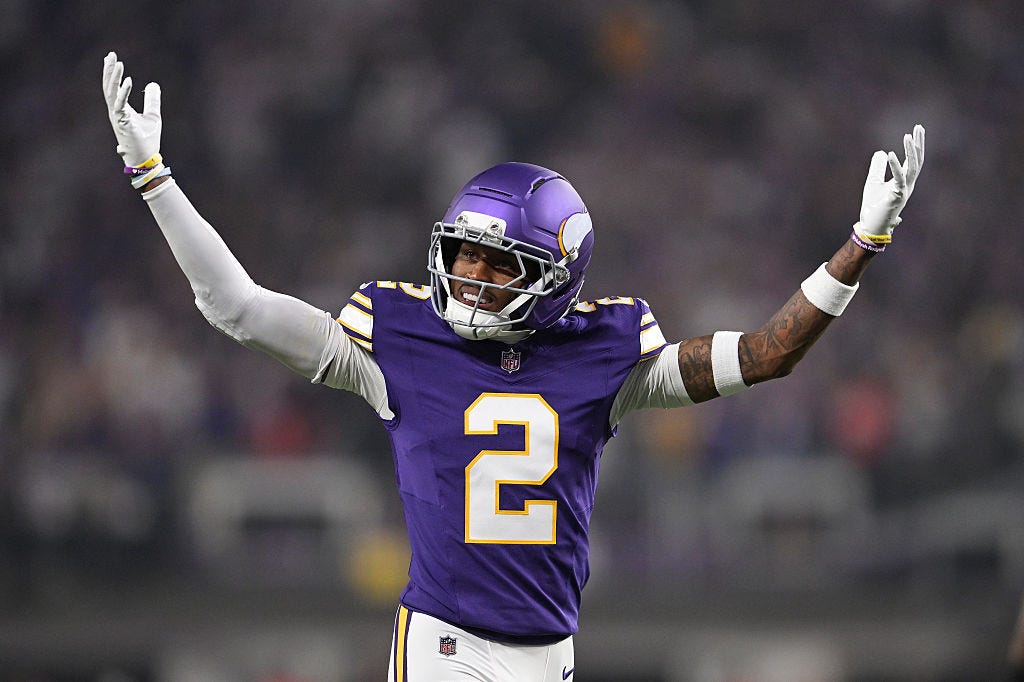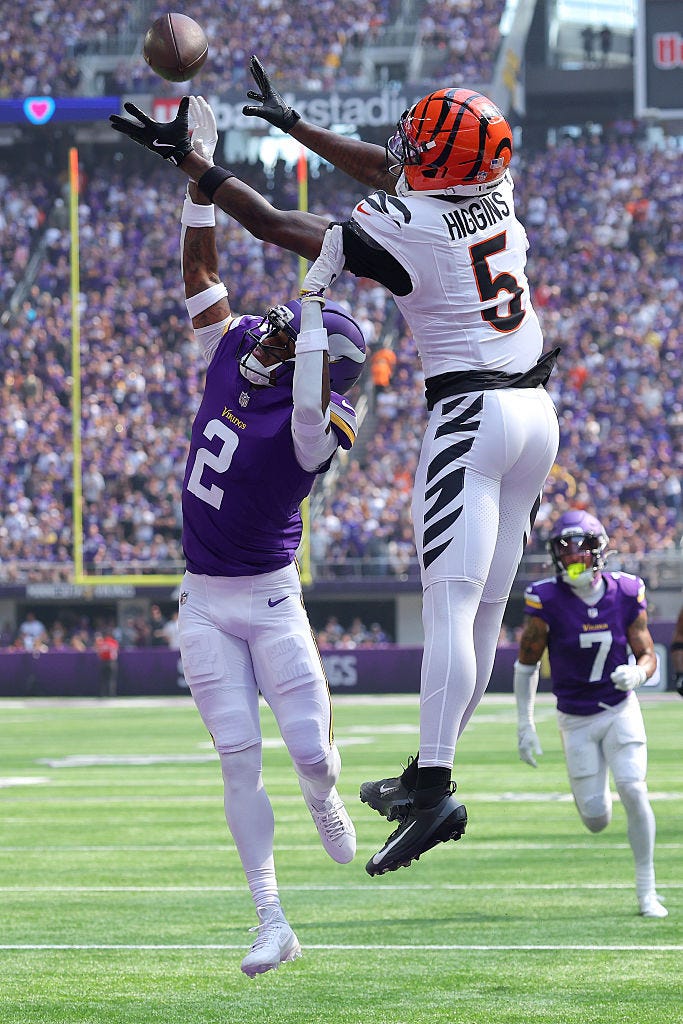Isaiah Rodgers and the Anatomy of a Perfect Game
Isaiah Rodgers had as close to a perfect game as we could ever see of a defensive back in an NFL game. Matt Fries breaks it down.
Brian Flores had a feeling about Isaiah Rodgers. He made that clear in the lead-up to free agency, and the Minnesota Vikings made signing Rodgers a priority. He was the first player the team agreed to terms with when free agency started, and, despite concerns from a host of outside analysts, including myself, about the team’s cornerback room, it was clear the Vikings saw him as a starter.
Kevin O’Connell discussed the signing and Flores’ confidence in Rodgers back in April, at the owner’s meetings, as chronicled in Will Ragatz’s SI article:
“Isaiah was a guy that Flo really identified pretty early, and historically, I haven’t been doing this long with Flo, but when Flo kinda has that tone in his voice about guys — I’m not gonna mention the other ones that he has had that in his voice about — but he’s been pretty darn accurate. And that guy, whether playing for us or somebody else, has immediately shown up. So no pressure on Isaiah, but he definitely got that evaluation from Flo.”
In particular, the last quote in the piece seems almost premonitory:
“I think he’s got the ability to make plays on the football, he’s got some ability to do something with it when he does catch it. Whether he ends up being a part of the return game or not is really just going to come down to how the rest of our roster shapes out. Because I see Isaiah being an every-down impact guy.”
In the Vikings’ 48-10 dismantling of the Cincinnati Bengals on Sunday, the nation learned that Rodgers does, in fact, have “some ability do something with [the football] when he [catches] it” to the tune of two defensive TDs, an 87-yard interception return and a 66-yard return on a fumble Rodgers forced himself. Rodgers also forced a second fumble that was recovered by Jeff Okudah, deflected a pass in the end zone meant for Tee Higgins, and made another tackle in the game.
Rodgers got a host of accolades for his performance, including NFC Defensive Player of the Week and Nickelodeon’s NVP of the Week. Perhaps the most explosive praise, however, was the 99.9 game grade PFF gave Rodgers. It’s the highest possible grade in PFF’s grading system, and the only one they’ve ever given.
You could reasonably call Rodgers’ performance a “perfect game.”
What Is A Perfect Game In Football?
The term “perfect game” is obviously most prevalent in baseball, where it means that a pitcher pitches a complete game of at least nine innings and doesn’t allow a single baserunner, retiring all 27 batters.
When trying to port the idea of a perfect game over to football, it’s hard to find an analogous situation. Baseball, as a sport, is a lot easier to evaluate than football. While the pitching team may have nine players on the field at a time, most interactions are one-on-one, typically between the pitcher and batter, or between a fielder and batter. Football, on the other hand, has 22 players moving simultaneously.
Sure, offensive players share a common goal with each other, as do defensive players. But they all have to work together as a unit, and none has the level of independence of a pitcher facing a batter.
It’s hard to even find one-on-one interactions in football. As a left tackle, your primary job in pass protection may be to block the edge rusher across from you one-on-one. But what if the defender stunts? Now, suddenly, you might have to block a looping defensive tackle.
As a cornerback, you might be assigned man coverage on a wide receiver, but even then, there are situations where you’d pass off an underneath crossing route, or a teammate, like a deep safety, would be responsible for helping you against a vertical route.
As humans, we seem to have the need to constantly make comparisons and value judgments. That desire drives the recording of statistics in sports, and the more rigid structure of baseball makes it easier to track statistics. The term “perfect game” is actually codified in the MLB rulebook.
The closest thing the NFL has to the perfect game is probably a perfect passer rating, a stat which is mathematically capped at 158.3 — a perfectly reasonable and non-arbitrary number.

But a baseball perfect game is only achievable by a pitcher, and a perfect passer rating is only realistically achievable by a quarterback.
What about other positions?
Sports like baseball and basketball have some easily countable statistics to examine. You could say that a perfect game for a batter is one where the player reaches base, scores a run, or hits a home run on each of his at-bats, depending on how restrictive you want to be. You could look for a basketball player who makes all their shots or commits no turnovers.
For football, it’s a lot more difficult. Only a few positions, like quarterback, wide receiver, and running back, consistently produce stats. Even then, factors outside of the player’s control frequently impact their stats — far more so than in baseball.
On defense, it’s even more difficult. I probably don’t need to dig up Arif’s piece on Chad Greenway [Ed. Note: I did not ask for this blast from the past, but here you go] to convince you that tackles are an unreliable stat, and plays like sacks, interceptions, forced fumbles, and pass deflections are low-frequency.
Going beyond counting statistics, some advanced statistics can give us insight into how a player performed. Pass block win rate could serve as a good indicator for offensive linemen, but different outlets, such as ESPN and PFF, record their version of the measure using different processes.
Rarity is also a concern. Perfect games by passer rating are a lot more common than perfect games in baseball. Baseball has had just 24 perfect games out of 154 years of history and over 238,500 games played.
Even if you limit it to a quarterback with at least 20 attempts in a game, there are 41 QBs who have had a perfect passer rating in NFL history — out of a universe of 17,000 games. That makes a perfect passer rating about 24 times more likely than a perfect game.
All of this is to say that it’s impossible to get a truly objective measure for what comprises a perfect game for Isaiah Rodgers. But Rodgers’ PFF grade creates a compelling case. PFF’s goal is to grade every player in every game.
That means they’ve graded over 4,900 NFL games since their founding in 2006. If you consider that 22 players start on offense or defense in those games, that’s over 108,000 total player games that PFF has graded, not even including rotational players. Rodgers’ grade was the best ever by that metric, and almost certainly good enough to call a perfect game.
It’s worth mentioning that PFF’s grading, especially the updated Madden-style 0-100 scale, is far from perfect (although if you want to read a more detailed analysis on that subject, Wide Left has you covered).
But rather than taking an outside source’s word for it, I always want to analyze a player’s game in detail myself. So next, let’s review Rodgers’ game and take a look at what exactly made it so perfect.
Film Study
Let’s start with the interception. The Bengals were down 7-0, but in scoring position on their second drive of the game. On the play, the Bengals have a unique formation with receivers Ja’Marr Chase and Tee Higgins stacked up top, tight end Noah Fant and running back Chase Brown tight to the line of scrimmage at the bottom, and tight end Drew Sample in the backfield, likely to help pass protect. Given that this is a two-minute drill situation, this was clearly going to be a pass from the Bengals.
The Vikings show what appears to be single high at the snap, but quickly rotates into a Tampa-2 look. Rodgers has the flat responsibility at the bottom of the screen, where the Bengals run a smash concept with Fant and Chase.
Quarterback Jake Browning quickly progresses from the smash concept, which should theoretically beat most versions of Cover-2. Either he’s a little confused by the funky coverage or he thinks Rodgers plays it too well, getting enough depth to undercut the corner by Fant but still staying close enough to the flat by Brown.
Defensive tackle Levi Drake Rodriguez quickly gets pressure on the play, and that sets events in motion. Browning scrambles, and Harrison Smith does a good job of initially plastering to Chase’s route but then coming off of that to undercut Browning’s throw to Brown. He tips the pass, and it goes right into Rodgers’ hands.
While Rodgers’ coverage on this play was technically sound, it wasn’t anything special. The real special play came after the catch. Rodgers was able to turn upfield by only putting a hand on the ground, but he quickly had Higgins dive at his feet from behind to try to tackle him. Rodgers is able to keep his footing, and then his elite acceleration and 4.28 speed took over (Next Gen Stats recorded him running at a max speed of 20.8 miles per hour).
With a great block from Jonathan Greenard, he had a clear path to the end zone:
After a couple of drives, the Bengals finally got into scoring position again, and Rodgers made what might have been my favorite play of his from the game. The Bengals were in 3rd and 8, and the Vikings made a late shift into their (aptly named) “Bengal” formation running their signature Cover Zero blitz, Hawk.







